 W
WPoultry are domesticated birds kept by humans for their eggs, their meat or their feathers. These birds are most typically members of the superorder Galloanserae (fowl), especially the order Galliformes.
 W
WThe African goose is a breed of domestic goose derived from the wild swan goose. Despite the name the African goose most likely originated in China, like the related Chinese goose. Though the African goose and Chinese goose share some characteristics, the two can be distinguished by the African's larger dewlap and different knob shape. African geese are also quite a bit heavier than Chinese, and are known for their docile temperament. Also, they lay fewer eggs than Chinese geese: 25 to 40 eggs per year for the African goose against 40 to 65, or, in extreme cases, up to 200 eggs per year for Chinese goose.
 W
WA bantam is any small variety of fowl, usually of chicken or duck. Most large chicken breeds have a bantam counterpart, which is much smaller than the standard-sized fowl, but otherwise similar in most or all respects. A true bantam chicken is naturally small and has no large counterpart.
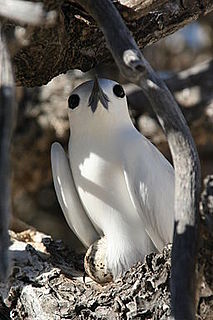 W
WBroodiness is the action or behavioral tendency to sit on a clutch of eggs to incubate them, often requiring the non-expression of many other behaviors including feeding and drinking. Being broody has been defined as "Being in a state of readiness to brood eggs that is characterized by cessation of laying and by marked changes in behavior and physiology". Broody birds often pluck feathers from their chest and abdomen, using them to cover the eggs. As a consequence of this, they develop one or several patches of bare skin on the ventral surface. These reddish, well-vascularized areas of skin are usually called brood patches, and improve heat transfer to the eggs. Broodiness is usually associated with female birds, although males of some bird species become broody and some non-avian animals also show broodiness.
 W
W"Bush legs" is a prevailing term in the post-Soviet states that denotes chicken leg quarters from the United States.
 W
WThe chicken is a type of domesticated fowl, a subspecies of the red junglefowl. Chickens are one of the most common and widespread domestic animals, with a total population of 23.7 billion as of 2018. up from more than 19 billion in 2011. There are more chickens in the world than any other bird or domesticated fowl. Humans keep chickens primarily as a source of food and, less commonly, as pets. Originally raised for cockfighting or for special ceremonies, chickens were not kept for food until the Hellenistic period.
 W
WDelayed-feathering in chickens is a genetically determined delay in the first weeks of feather growing, which occurs normally among the chicks of many chicken breeds and no longer manifests itself once the chicken completes adult plumage.
 W
WDomestic ducks are ducks that are raised for meat, eggs and down. Many ducks are also kept for show, as pets, or for their ornamental value. Almost all varieties of domestic duck apart from the Muscovy duck are descended from the mallard.
 W
WDomestic geese are domesticated grey geese that are kept by humans as poultry for their meat, eggs and down feathers since ancient times. Approximately 700 million geese are slaughtered each year for meat worldwide.
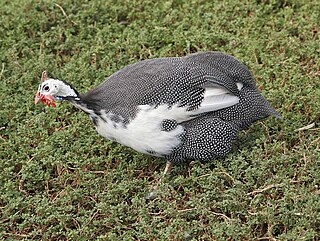 W
WDomestic guineafowl, sometimes called pintades, pearl hen, or gleanies, are poultry originating from Africa. They are the domesticated form of the helmeted guineafowl and are related to other game birds such as the pheasants, turkeys and partridges. Although the timing of their domestication is unknown, there is evidence that domestic guineafowl were present in Greece by the 5th century BC.
 W
WThe domestic turkey is a large fowl, one of the two species in the genus Meleagris and the same as the wild turkey. Although turkey domestication was thought to have occurred in central Mesoamerica at least 2,000 years ago, recent research suggests a possible second domestication event in the Southwestern United States between 200 BC and AD 500. However, all of the main domestic turkey varieties today descend from the turkey raised in central Mexico that was subsequently imported into Europe by the Spanish in the 16th century.
 W
WDubbing is the procedure of removing the comb, wattles and sometimes earlobes of poultry. Removing the wattles is sometimes called "dewattling".
 W
WIn cooking and gastronomy, duck or duckling is the meat of several species of bird in the family Anatidae, found in both fresh and salt water. Duck is eaten in many cuisines around the world. It is a high-fat, high-protein meat rich in iron. Duckling nominally comes from a juvenile animal, but may be simply a menu name.
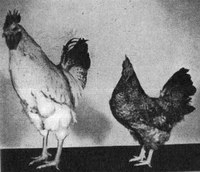 W
WDwarfism in chickens is an inherited condition found in chickens consisting of a significant delayed growth, resulting in adult individuals with a distinctive small size in comparison with normal specimens of the same breed or population.
 W
WGame or quarry is any animal hunted for food, and the meat of those animals. The type and range of animals hunted for food varies in different parts of the world.
 W
WSome terms used for the feathers of poultry are identical to those used for feathers of other birds, while others are specific to poultry. They include:
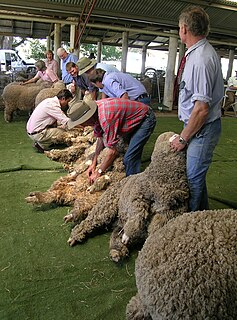 W
WA livestock show is an event where livestock are exhibited and judged on certain phenotypical breed traits as specified by their respective breed standard. Species of livestock that may be shown include pigs, cattle, sheep, goats, horses, llamas and alpacas. Poultry such as chickens, geese, ducks, turkeys and pigeons are also shown competitively. A livestock show may be part of an agricultural show.
 W
WThe National Thanksgiving Turkey Presentation is a ceremony that takes place at the White House every year shortly before Thanksgiving. The President of the United States is presented with a live domestic turkey by the National Turkey Federation (NTF), usually males of the Broad Breasted White variety. The early years also included a joint presentation with the Poultry and Egg National Board. The ceremony dates back to the 1940s, with presidents occasionally sparing the bird presented to them; during the Presidency of George H. W. Bush, it became a tradition for the president to issue a "pardon" to the turkey, sparing the turkey's life. It's a tradition that the turkeys be picked from the chairperson of the NTF's home state, occasionally from the chair's own farm.
 W
WA nest is a structure built for certain animals to hold eggs, offspring, and, often, the animal itself. Although nests are most closely associated with birds, members of all classes of vertebrates and some invertebrates construct nests. They may be composed of organic material such as twigs, grass, and leaves, or may be a simple depression in the ground, or a hole in a rock, tree, or building. Human-made materials, such as string, plastic, cloth, or paper, may also be used. Nests can be found in all types of habitat.
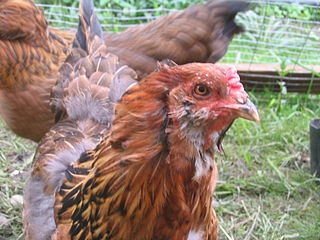 W
WPecking order or peck order is the colloquial term for the hierarchical system of social organization. It was first described by Thorleif Schjelderup-Ebbe in 1921 under the German terms Hackordnung or Hackliste and introduced into English in 1927.
 W
WThe common pheasant is a bird in the pheasant family (Phasianidae). The genus name comes from Latin phasianus, "pheasant". The species name colchicus is Latin for "of Colchis", a country on the Black Sea where pheasants became known to Europeans. Phasianus diverged from the genus Gallus, the genus of junglefowl and domesticated chickens, about 20 million years ago.
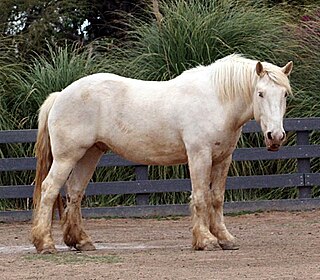 W
WIn modern agriculture, a rare breed is a breed of poultry or livestock that has a very small breeding population, usually from a few hundred to a few thousand. Because of their small numbers, rare breeds may have a threatened conservation status, and they may be protected under regional laws. Many countries have organizations devoted to the protection and promotion of rare breeds, for which they each have their own definition. In botany and horticulture, the parallel to rare animal breeds are heirloom plants, which are rare cultivars.
 W
WIn culinary terminology, squab is a young domestic pigeon, typically under four weeks old, or its meat. The meat is widely described as tasting like dark chicken. The term is probably of Scandinavian origin; the Swedish word skvabb means "loose, fat flesh". It formerly applied to all dove and pigeon species, such as the wood pigeon, the mourning dove, the extinct-in-the-wild socorro dove, and the now-extinct passenger pigeon, and their meat. More recently, squab meat comes almost entirely from domesticated pigeons. The meat of dove and pigeon gamebirds hunted primarily for sport is rarely called squab.